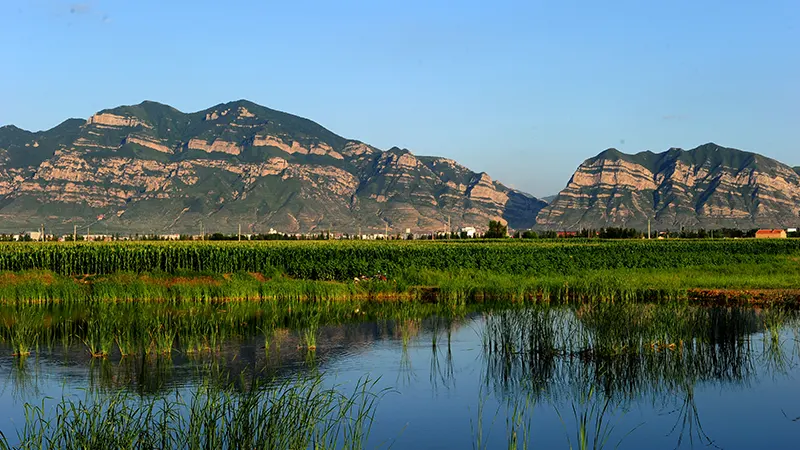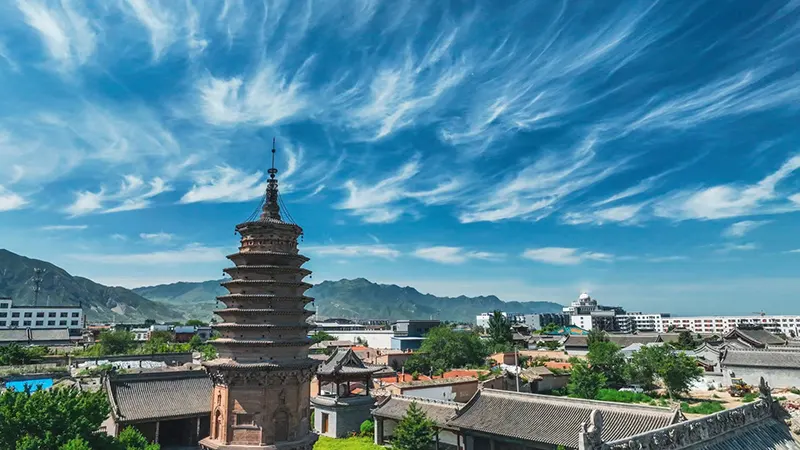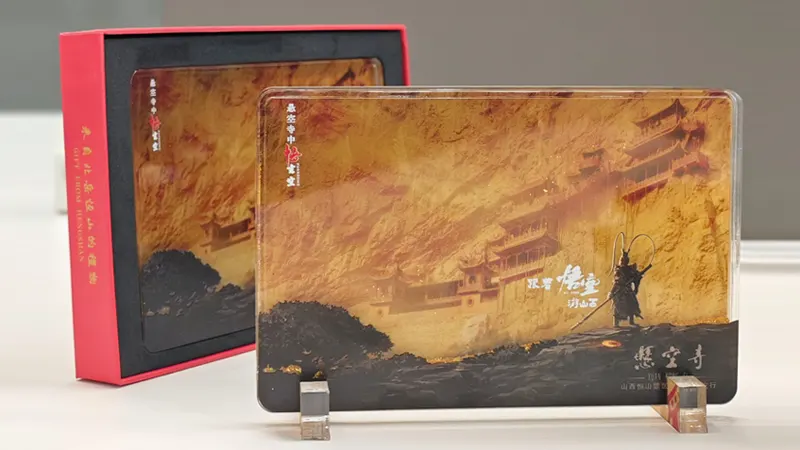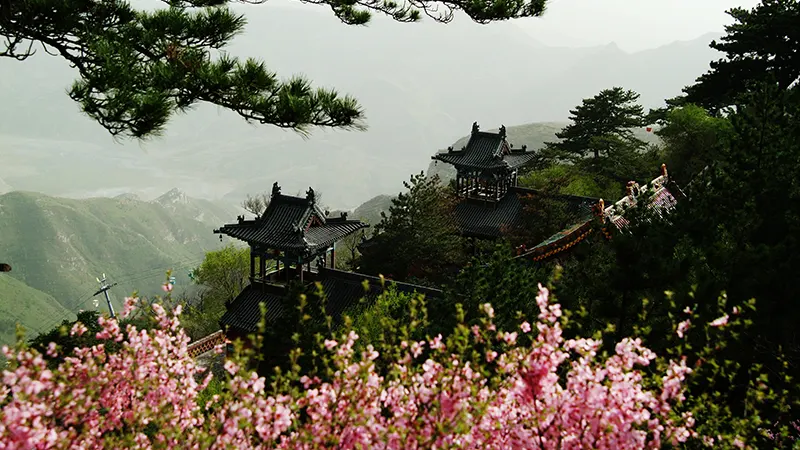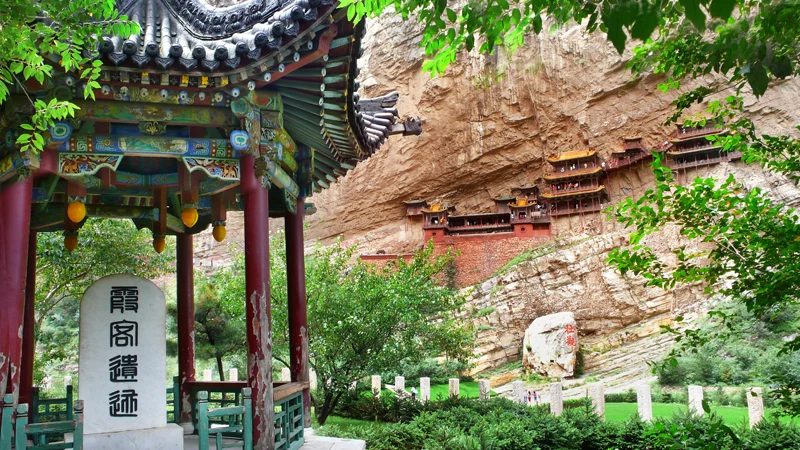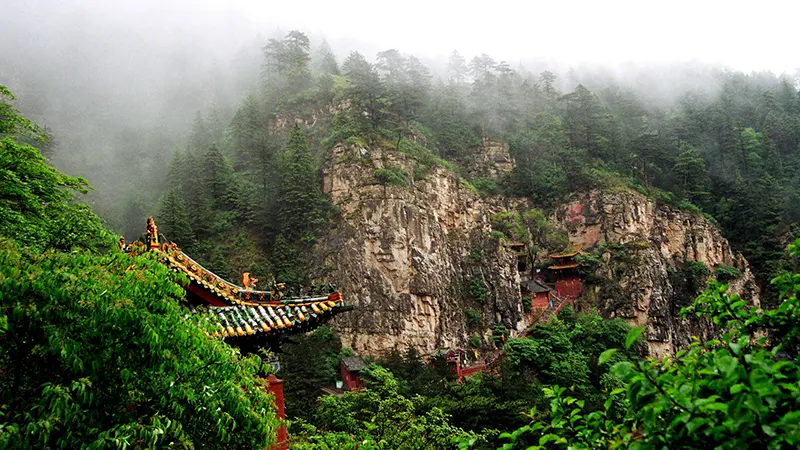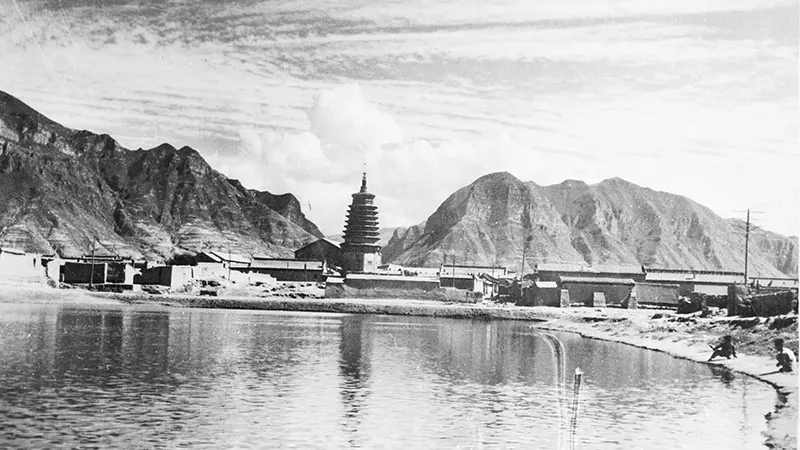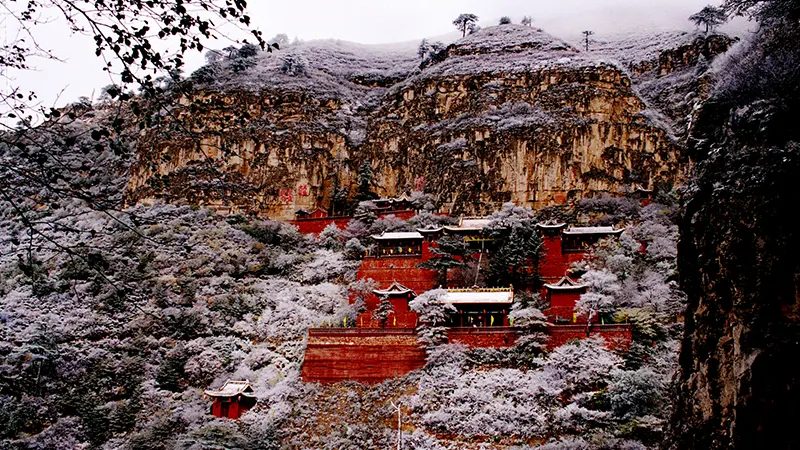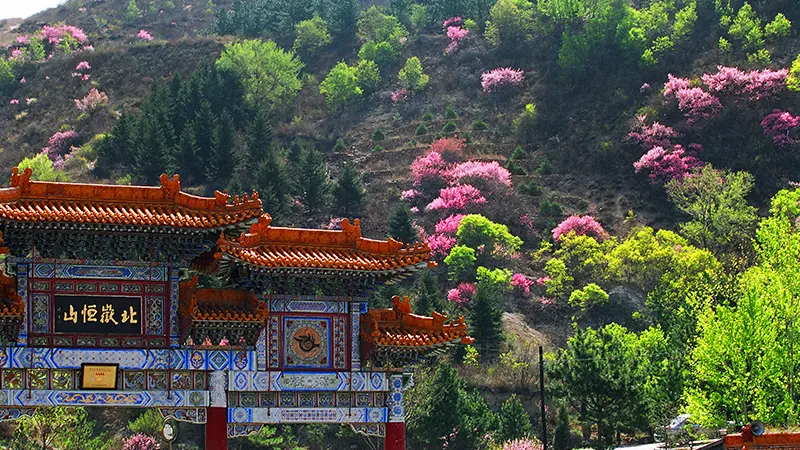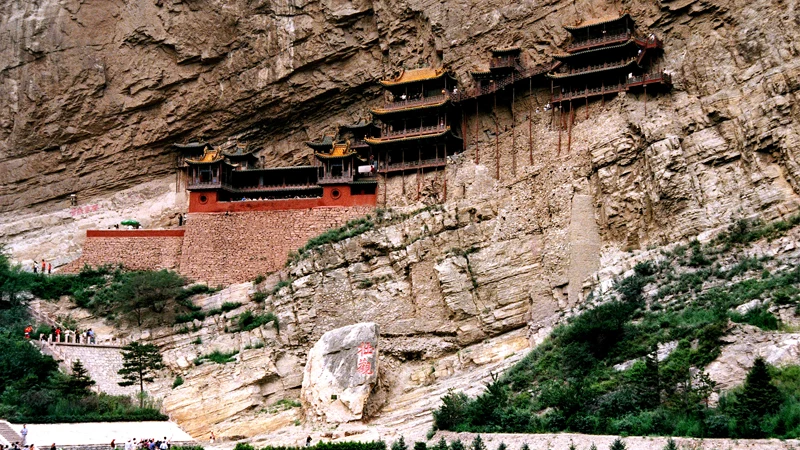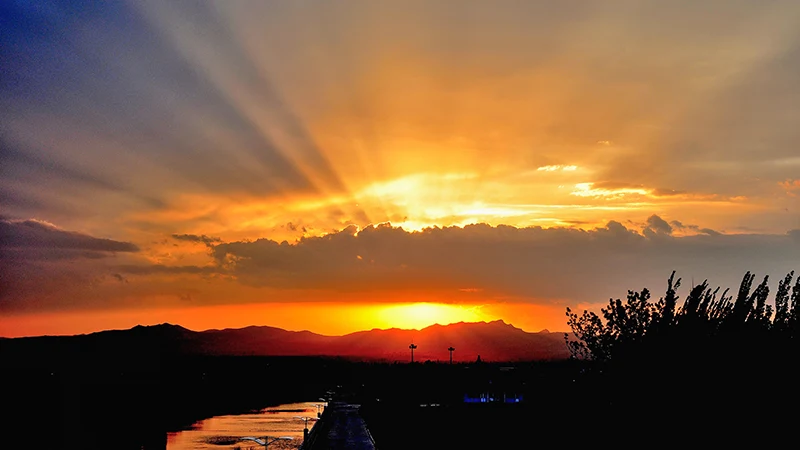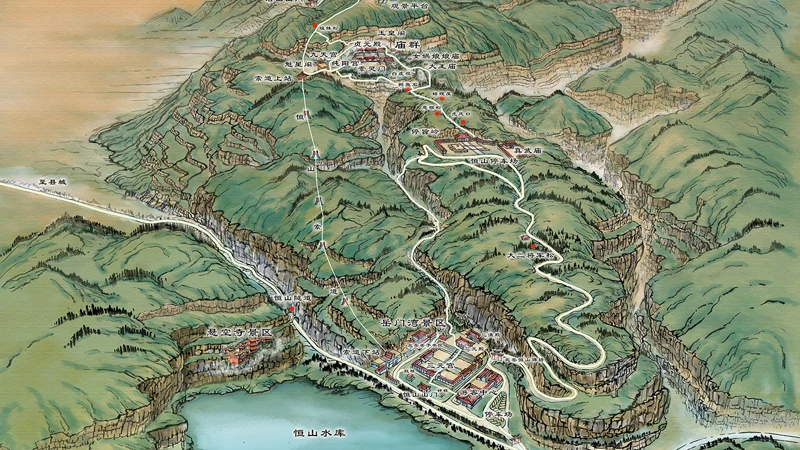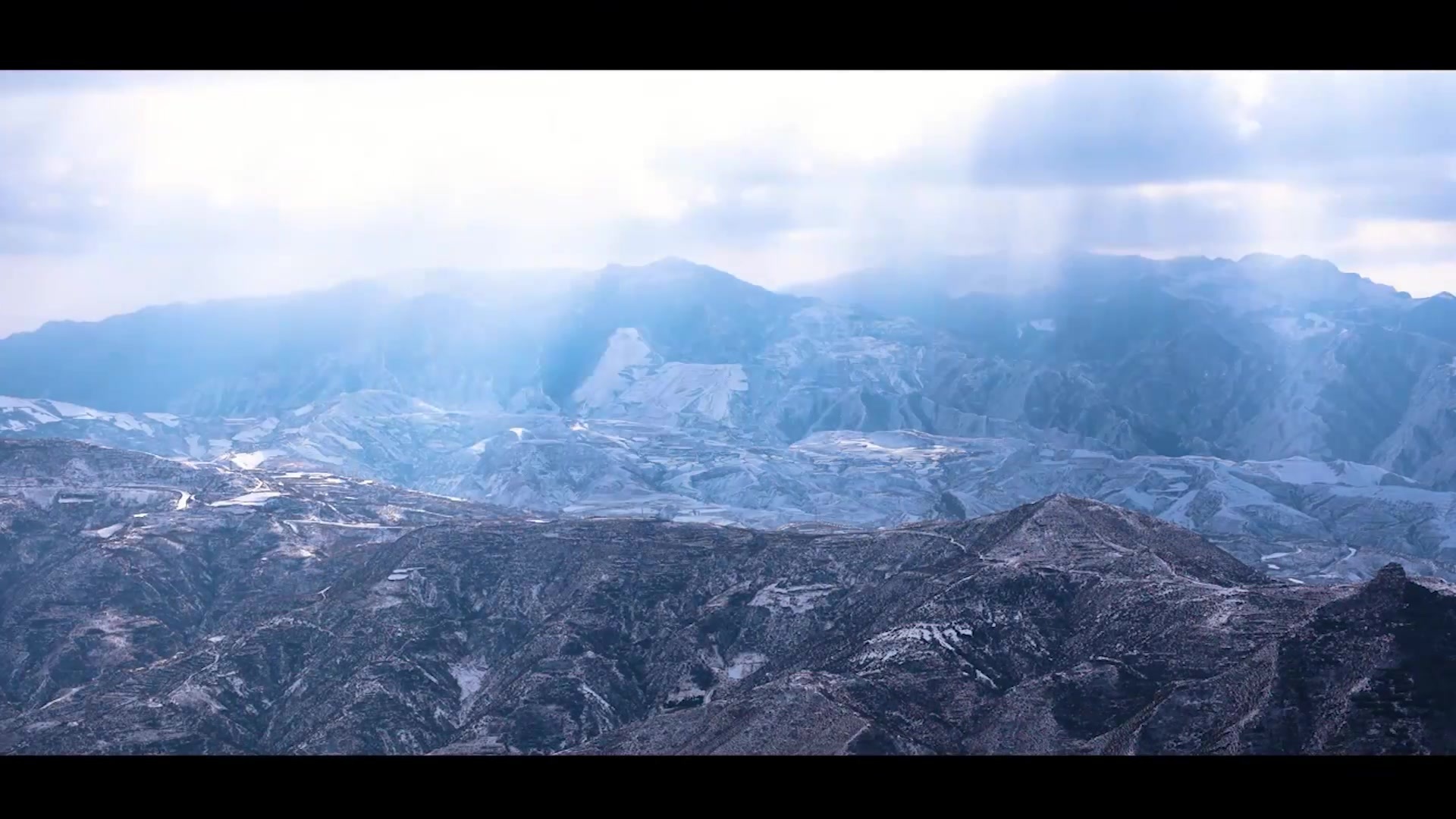A Preliminary Study of the Ancient Local Gazetteers of Hunyuan
Publish Time:
2025-03-14 13:51
Source:
HunYuan, possessing the magnificent Hengshan Mountain, has been one of the hallmarks of Chinese civilization since ancient times. In ancient times, when local histories of HunYuan were compiled, in addition to the main compilation of the "HunYuan Prefecture Records", a supplementary compilation of the "Hengshan Mountain Records" was mostly included.
Hunyuan, possessing the beauty of Mount Heng, has been one of the landmarks of Chinese civilization since ancient times. In compiling local histories in ancient Hunyuan, besides the main compilation of the "Hunyuan Prefecture Annals," most would also compile a supplementary "Hengshan Mountain Annals." However, the question of exactly how many versions of the "Prefecture Annals" and "Mountain Annals" have existed throughout history, which versions have been lost, and which versions have been passed down to the present day, has been a major question that Hunyuan cultural figures have diligently sought to answer.
Fortunately, there is Professor Zhang Haijun, whose deep affection for his hometown has led him to pay attention to local classics for decades, meticulously examining historical materials and diligently unearthing hidden knowledge, resulting in the article "A Study of Ancient Hunyuan Local Annals." This work answers many questions. Its breadth of research, strong summarization, detailed presentation, and precise analysis are truly admirable.
This article was first published in the "Mount Heng Newspaper" around 2005. This publication has obtained the author's authorization to reprint and publish it. Please refer to it.
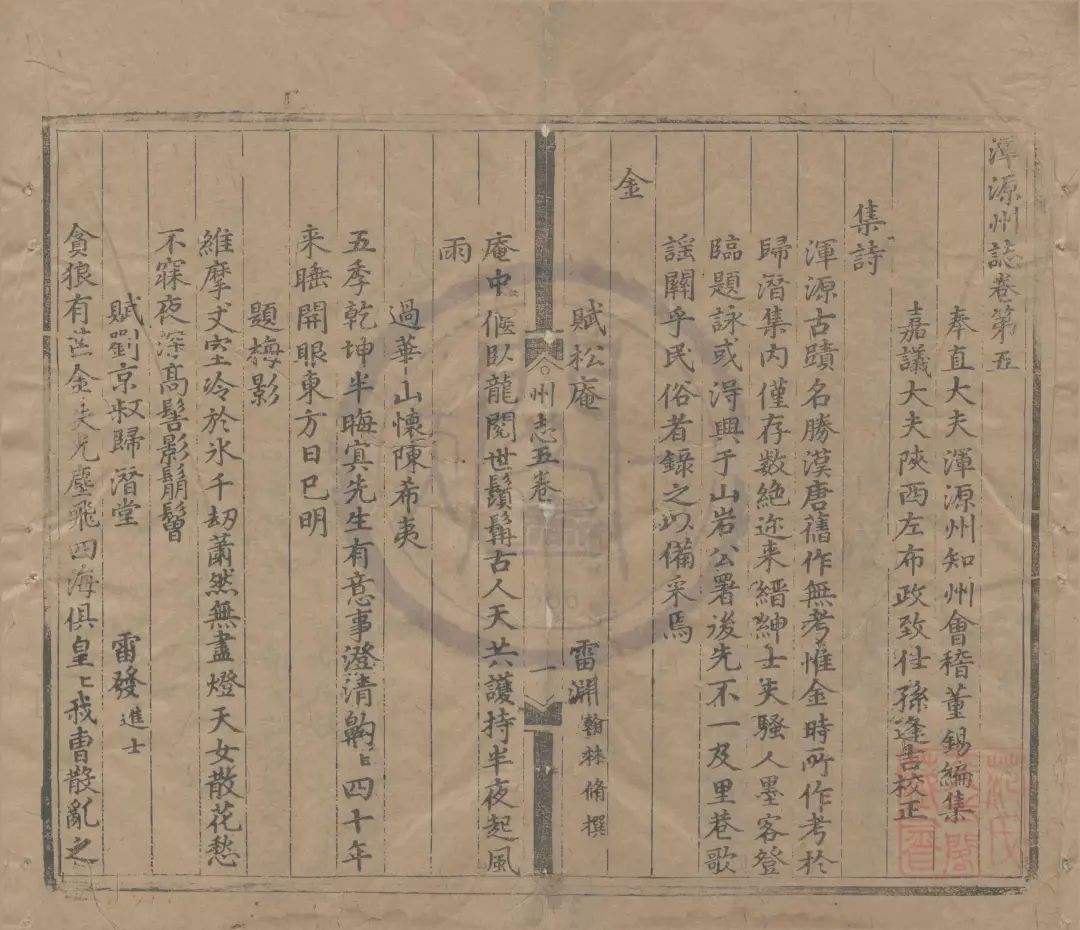
▲Ming Hongzhi Edition of "Hunyuan Prefecture Annals" Tianyi Pavilion Collection
Local annals are important carriers of history and culture, and are important markers of human civilization. Hunyuan is one of the origins of the Five Mountains culture, with a long history, developed culture, and local literature with a long history and profound depth. During the Sui and Tang dynasties, there were detailed records of Hunyuan in the literature. Tracing back further, during the Han, Jin, and Northern and Southern Dynasties periods, descriptions of Hengshan Mountain already appeared in various writings. Since the Ming and Qing dynasties, frequent wars have resulted in the loss of many Hunyuan local annals. After careful examination, sorting, and collation, based on my own knowledge, I will describe them separately from the (prefecture) county annals and Hengshan Mountain specialized annals, providing references for scholars while also aiming to address the biases in historical materials, fill in gaps in research and verification, clarify the context of Hunyuan civilization, and enrich the cultural connotations of Hunyuan local annals.
A1 Hunyuan Prefecture (County) Annals
1. "Hunyuan Prefecture Record," written by Zhu Bian of the Song Dynasty. Bian, whose courtesy name was Shao Zhang, was from Wuyuan, Huizhou (present-day Anhui). He was a court official, and was detained during his mission to Jin. From Jianyan 2 (1128) to Shaoxing 13 (1143), he lived in Datong, and later returned to Song. This book was written during his stay in Datong. According to the "Comprehensive Geography of the World," this book was lost by the end of the Ming Dynasty, and one entry was compiled in "Compilation of Lost Ancient Shanxi Local Annals."
2. "Hunyuan Prefecture Atlas and Gazetteer." The author is unknown, and it was probably written at the end of the Yuan Dynasty or the beginning of the Ming Dynasty. It is cited in the "Comprehensive Geography of the World." It was lost by the end of the Ming Dynasty, and one entry was compiled in "Compilation of Lost Ancient Shanxi Local Annals."
3. "Hunyuan Prefecture Annals," compiled from Yongle 19 (1421) to Zhengtong 6 (1441) of the Ming Dynasty. It is recorded in "Wenyuange Book Catalogue," volume 20. It was lost around the end of the Ming Dynasty. The original work in "Wenyuange Book Catalogue" is titled "Hunyuan County Annals." Considering that Hunyuan was a prefecture during the Ming Dynasty, "county" should be a mistake for "prefecture." The content of this book was compiled in the Chenghua edition of "Shanxi General Annals," and two entries were recorded in "Compilation of Lost Ancient Shanxi Local Annals."
4. "Hunyuan County Annals," compiled from Yongle 19 (1421) to Zhengtong 6 (1441) of the Ming Dynasty. It was lost around the end of the Ming Dynasty. It is recorded in the new edition of "Wenyuange Book Catalogue."
5. "Hunyuan Prefecture Annals" (Hongzhi Edition), five volumes. Compiled by Dong Xi and Yang Dayong of the Ming Dynasty. Xi, from the Imperial Medical Office, was from Huiji, Zhejiang. He was a student official, and in Hongzhi 2 (1489), he was the magistrate of Hunyuan Prefecture, and later promoted to the Zongrenfu. Dayong was from Hunyuan, and was a Jinshi during the Chenghua era, and served as the magistrate of Zixian County in Hunan. Examining the county annals, Zhu Bian of the Song Dynasty compiled "Hunyuan Prefecture Record." Before the Ming Dynasty, there were "Hunyuan Atlas and Gazetteer" and "Hunyuan Prefecture Annals." The above annals were cited in "Comprehensive Geography of the World," "Ming Yitong Zhi," and the Chenghua edition of "Shanxi General Annals," and have all been lost. After Xi took office, he commissioned Dayong to compile and extensively research based on the handwritten annals of Li Yi, covering various aspects such as customs, taxation, geography, establishment, history, mountains and rivers, terrain, historical sites, famous officials, and elections, totaling about 30,000 characters. This record ends in Hongzhi 3, and was printed in Hongzhi 6, making it the oldest extant county annals. The text states: Hunyuan was originally the land of Aolai Mountain and Pingshu in the Han Dynasty. Because the Hun River originates from the Hanqi Valley, ten miles southeast of the prefecture, the county was established in the Later Tang Dynasty, hence the name. Customs are described as follows: The people are simple and honest, the men work hard, and do not engage in commerce, and the women do not engage in sericulture, sewing, or other crafts, and are quite hardworking. They use Buddhist practices for coronations and funerals. Scholars enjoy banquets, and many families have aged wine. During the year, they attach great importance to the worship of the Yuan Dynasty and hold grand celebrations, offering sacrifices to their ancestors and friends. The Hongzhi 6 edition of this book is now only extant in the Tianyi Pavilion, with only a fragment of volume 5 remaining.
6. "Hunyuan Prefecture Annals" (Jiajing Edition). Compiled by Yan Shouxian and Li Yaonian of the Ming Dynasty. Shouxian was from Yizhou, Beizhili (present-day Yixian County, Hebei), and served as the magistrate of Hunyuan Prefecture during the Jiajing era. Yaonian was from Hunyuan, and was the magistrate of Yutai County in Shandong. This book was compiled in Jiajing 45 (1566) of the Ming Dynasty, and was lost around the end of the Ming Dynasty. The prefaces by Li and Yan are extant in "Compilation of Lost Ancient Shanxi Local Annals."
7. "Hunyuan Prefecture Annals" (Wanli Edition), two volumes. Compiled by Zhao Zhihan and Wang Junchu of the Ming Dynasty. Zhihan was from Si Shui, Henan (present-day Xingyang). He was a Jinshi, and in Wanli 38 (1610), he was the magistrate of Hunyuan Prefecture. Junchu was from Shanyin, and was a Jinshi. In year 39, Zhihan revised the Hongzhi Annals, reducing it to two volumes, and the book was completed and printed the following year, ending in year 40. It covers nine categories and 49 items, including geography, establishment, food and goods, military administration, officials, elections, figures, arts and literature, and miscellaneous records. Only one incomplete volume remains, containing 20,000 characters. The preface includes three maps: territory, city walls, and prefecture smelter. The historical development states: (Hunyuan) belonged to Jizhou in the Tang Dynasty, Aolai County in the Western Han Dynasty, Shicheng in the Northern Wei Dynasty, Kuozhou in the Eastern Wei Dynasty, Pingkou County at the beginning of Kaihuang in the Sui Dynasty, and Hunyuan from the Later Tang Dynasty to the present. The mountains and rivers are mainly based on the Hengshan Mountain range, and include other mountains and rivers. The customs section quotes "Hunyuan Atlas and Gazetteer," stating: The four classes of people have a simple and honest temperament, each adhering to their own profession without change, and are able to live frugally. The population section states: The wind on the border is constant, and early frost makes the harvest rare, and the people are also lazy and wasteful, with extravagant funerals, and their farming is almost unproductive. The magistrate section starts from the Yuan Dynasty, and the Jinshi section records 26 Jinshi from the Yuan Dynasty, with some biographies, all recording the year they passed the examination. The military Jinshi section states: According to the old annals, the subject was particularly prosperous in the Jin Dynasty, and there is also a record by Zhang Du of the Yuan Dynasty. It is unknown what Zhang Du refers to. This annals is one of the most complete in terms of format among the Ming Dynasty local annals. The Shanxi Provincial Library has a microfilm copy of the incomplete volume from the Beijing Library. The incomplete volume is only extant in the Beijing Library.
8. "Hunyuanzhou Zhi" (Shunzhi), two volumes, compiled by Zhang Chongde of the Qing Dynasty. Chongde, courtesy name Maoxiu, was from Changli, Zhili (present-day Hebei). In the fifteenth year of Shunzhi (1658), he was promoted from magistrate of Weinan County to the prefect of Hunyuan. During his tenure, he donated his salary to relieve famine, eliminated the malpractice of local militias and forced labor, and established the Shahe market to promote trade. He compiled the "Hunyuanzhou Zhi" and the "Hengyue Zhi." The "Hunyuanzhou Zhi" is divided into ten sections and thirty-eight categories, with an additional forty categories. This gazetteer has a mixed classification, far inferior to his compilation of the "Hengyue Zhi." However, this gazetteer added events from the Wanli to Shunzhi periods, which is helpful in understanding the historical events of the late Ming and early Qing Dynasties. It lacks verification and does not pay attention to collecting inscriptions on stone tablets and steles, which is a shortcoming. This book was printed in the eighteenth year of Shunzhi. It is currently held in the Shanxi Provincial Library, the Beijing Library, and the Hong Kong Chinese University Library.
9. "Hunyuanzhou Zhi" (Qianlong), ten volumes, compiled by Gui Jingshun of the Qing Dynasty. Jingshun was the prefect of Hunyuanzhou in the twenty-third year of Qianlong (1758). The gazetteer was compiled in the twenty-seventh year, divided into thirty-one sections. There are seventeen illustrations at the beginning of the book, adding eight scenic spots and famous places compared to the Shunzhi gazetteer. From the perspective of the city, the city wall is octagonal, which is quite rare among city sites. The Yuanjue Temple, built by Jin and repaired by Ming, and the Yong'an Temple, founded in the Yuan Dynasty and repaired in the Qing Dynasty, are both illustrated. However, the Hanging Temple, known as the number one scenic spot of Hengshan Mountain, is not illustrated for some reason. Although the county is not located on the Great Wall, there is a Meng Jiangnu Temple (see the Temples section of the book), which is quite thought-provoking. The book includes a section on women with appended longevity, listing two women over 100 years old, the oldest being 103, with five generations living together. This section is also extremely rare in gazetteers from the Ming and Qing Dynasties. April 8th is generally the birthday of Buddha, but in Hunyuan, it is the day of the Hengshan Mountain temple ceremony of Taoism (see Customs section). Since the county has Hengshan Mountain and there is a separate "Hengshan Mountain Zhi," the section on mountains and rivers is very brief. The section on officials has some omissions. Zhang Pu, the prefect in the third year of Hongwu (1370), and Deng Yue, the prefect in the eighteenth year of Hongzhi (1505), recorded in the Zhengde edition of "Datongfu Zhi," are not recorded, which can be supplemented. Moreover, the section on officials (Ming Dynasty) only records the reign year and the person in office, without specifying the year, which is a shortcoming. There is a Qianlong twenty-eighth year edition and a Tongzhi ninth year edition engraved by Kong Guangpei. The Kong Guangpei edition added five documents, including his "Record of the Reconstruction of Hunyuanzhou City." The Qianlong and Tongzhi editions are both held in the Beijing Library. The Qianlong edition is also held in the Shanxi Provincial Library, Henan Provincial Library, and Shanghai Library. A vernacular lead-printed edition from 1983 by the Hunyuan County Gazetteer Office is also extant.
10. "Hunyuanzhou Xuzhi" (Guangxu), ten volumes, compiled by He Shuen and Cheng Ji, et al. Shu'en was the prefect of Hunyuan in the sixth year of Guangxu (1880). Ji was from Hunyuan and a student. The gazetteer was compiled in the sixth year, divided into eleven sections and fourteen categories, with one additional category: illustrations and examinations, stars and fields, schools, ancestral temples, land tax, military system, people, officials, subjects, ancient sites, and literature and art. The section on auspicious and ominous events records the drought and poor harvest in the third year of Guangxu, with the local area donating 1,000 shi of rice for relief. There were three earthquakes in the fifth year of Guangxu. The section on filial piety includes biographies of 20 people, with an appended section on long-lived people, including Wang Yuanxi, who lived to be 102, and his wife, Zuo, who lived to be 104. This shows that there have been many long-lived people in Hunyuan since ancient times. It also records the names of those who donated rice for relief in the third year of Guangxu. The section on women adds 878 people since the Qianlong period. The section on literature and art has been greatly enriched, with detailed interviews and records of important events related to the construction of the city, the achievements of virtuous and talented people, and their conduct. Poems are selectively included. The Guangxu seventh year edition is held in the Shanxi Provincial Library.
A2 Hunyuan Maps and Gazetteers
1. Sketch Map of Hunyuan County, produced by the Hunyuan County Government. Ink drawing, scale not specified, drawn in the Republic of China period, held in the Beijing Library.
2. Complete Map of Hunyuan County, produced by the Hunyuan County Finance Bureau. Ink-printed edition. Scale 1:136300, 59.7*50.8cm, printed in the twentieth year of the Republic of China (1931). Held in the Beijing Library.
B1 Hengshan Mountain Gazetteers
1. "Beiyue Bian," three volumes and one preface. Edited by Huangfu Tan et al. of the Ming Dynasty. Beiyue (Northern Mount) was one of the mountains where emperors of successive dynasties held sacrifices, with numerous steles and inscriptions, and historical records. During the Jiajing period, Hou Tingxun, the county magistrate of Quyang, first initiated the compilation, applying to the inspector Shi Shan. Shi then ordered Tingxun et al. to collect and collate materials, with Huangfu Tan as the chief editor. The book was completed in the eleventh year of Jiajing. The entire book was printed in blue, and it is only known that the Chinese Department of the Library of Congress has a copy. The Beijing Library has a fragmentary copy, which is very precious.
2. "Hengyue Zhi," two volumes. Initially compiled by Zhao Zhihan and Wang Jun of the Ming Dynasty. Zhihan and Junchu are recorded in the preface of the Wanli "Hunyuanzhou Zhi." This book was completed in the fourteenth year of Wanli (1612), with two volumes divided into eleven sections: outer history, star history, mountain history, temple history, sacrifice history, event history, object history, travel history, immortal history, literature history, and poetry history. Since the Han Dynasty, it has been believed that Beiyue is located in Quyang County (present-day Quyang County, Hebei Province). Especially since the Song Dynasty, the Beiyue Temple was built in Quyang, and sacrifices were more frequent than in previous dynasties. Therefore, this book includes poems from the Quyang Yue Temple at the end. The practice of sacrificing Beiyue in Quyang was a misconception until the seventeenth year of Shunzhi (1660), when Zhang Chongde, the prefect, petitioned to change the sacrifice to Hengshan Mountain in Hunyuan. This was five years after the completion of the gazetteer. It was published by Zhang Baoling, the prefect, but the section on literature is empty. It is listed in the Qing Qianlong "Siku Quanshu Zongmu" but needs further investigation.
3. "Records of Mount Heng" (恒岳志), three volumes. Compiled by Zhang Chongde of the Qing Dynasty. Chongde is recorded in the preface of the "Records of Hunyuan Prefecture" (浑源州志) of the Shunzhi era. Hunyuan was established as a county since the late Tang Dynasty and was elevated to a prefecture in the third year of Jin Zhenyou (1215). Since the Ming Dynasty, it has been under the jurisdiction of Datong Prefecture. Hengshan Mountain is located twenty li south of Hunyuan City. However, since the Han Dynasty, it has been worshipped in Shangquyang County (present-day Quyang County, Hebei). In the seventeenth year of Shunzhi (1660), Zhan Bensheng, the Metropolitan Censor, proposed to change the place of worship to Hunyuan Prefecture. The Ministry ordered the officials of the Shanxi governor's office to investigate the remains of Hengshan Mountain. Zhang Chongde, based on the opinions of local gentry and elders, reported to the Qing court, forcefully arguing against the falsehood of the "flying stones" of Quyang and that the worship should be changed to Hengshan Mountain in Hunyuan. At that time, Wang Chongjian, the Minister of Rites, also advocated for changing the place of worship to Hengshan Mountain. Therefore, Chongde compiled the three-volume "Records of Mount Heng" in the seventeenth year of Shunzhi and had it printed the following year. This book is particularly detailed in its records of sacrificial rites, especially in correcting the falsehood of the Quyang "flying stones". Its profound examination and description of the scenery of Mount Heng are convincing. The woodblock prints of the eighteen scenic spots of Hengshan Mountain in the book still retain the style of the Ming Dynasty, which is particularly rare. The "General Catalogue of the Four Treasuries" (四库全书总目) includes this book, which is the earliest known extant monograph on Hengshan Mountain. It is a pity that there is no complete copy in public or private collections. The Shunzhi edition (1661) is known to have a fragmentary copy in Tianyi Pavilion in Ningbo. The Chinese Academy of Sciences Library and the Shanghai Library also have fragmentary copies, but upon examination, these are only listed in the catalog and the books themselves are lost. The "Bibliography of Rare Books in China" (中国古籍善本书目) records that the National Library has one copy, but according to the "Bibliography of Rare Books in the Beijing Library" (北京图书馆善本书目) and the "General Bibliography of Ancient Books in the Beijing Library" (北京图书馆普通古籍书目), there is no record. The Beijing Library only has the Qianlong edition of "Records of Hengshan Mountain" (Hengshan Mountain志), five volumes, which is the Qianlong twenty-eighth year (1763) edition printed by Gui Jingshun. What is gratifying is that in the nearly thirty years since the emergence of art auctions and private exchanges in China, two complete copies of this Shunzhi edition of "Records of Mount Heng" have appeared in private collections. Relevant research shows that the poems and writings of Dong Xi and others collected in "Records of Mount Heng" are the same as those in the original version of "Records of Mount Heng" by Zhao Zhihan and Wang Jun, so it can be inferred that Zhang Chongde's version of "Records of Mount Heng" has to a certain extent preserved the relevant materials of the Wanli edition, and its documentary value is self-evident.
4. "Records of Hengshan Mountain" (Hengshan Mountain志), five volumes. Written by Gui Jingshun of the Qing Dynasty. Jingshun was the prefect of Hunyuan and once compiled the "Records of Hunyuan Prefecture". In the twenty-eighth year of Qianlong (1763), he wrote this record. Volume 1 includes illustrations, imperial edicts, and astronomical records; Volume 2 includes eleven records on the shape, name, worship, enfeoffment, temples, objects, events, water, legends, immortals, and traces; Volume 3 is a chronological record; Volume 4 is a record of writings; and Volume 5 is a record of poems. Mount Heng is the northern peak among the Five Great Mountains, also known as Xuan Yue (玄岳), located south of Hunyuan, extending to the northwest of Quyang, Hebei. Since the Han Dynasty, most of the worship has been conducted at Mount Heng, 140 li northwest of Quyang (Shangquyang). Only during the Northern Wei Dynasty was there a temple to Mount Heng in Hunyuan, with envoys sent repeatedly to perform sacrifices. During the Ming Dynasty, there were temples to the Northern Peak in both Hunyuan and Quyang, but the official sacrificial rites were held in Quyang until they were moved to Hunyuan in the seventeenth year of Shunzhi. This record takes the Hengshan Mountain in Hunyuan as the main focus, while also including the Hengshan Mountain in Quyang, arranged chronologically, making it difficult to distinguish between the two. Most of the poems and writings included do not indicate their sources, and many have been abridged. For example, Emperor Xiaowen's "Sacrificial Text to the Northern Peak" is fourteen characters shorter than that quoted in "Early Learning Records" (初学记), Volume 5, and Emperor Taizong's sacrificial text is twenty-one characters shorter than that in "Complete Tang Writings" (全唐文), Volume 10. The Daoist canon entries cited in Volume 3 are far-fetched and superfluous. This book's materials are relatively complete and have some reference value. This book has editions printed in the twenty-eighth year of Qianlong, reprinted in the twenty-fourth year of Jiaqing (1819), and printed in the fifth year of Guangxu (1879). The Shanxi Provincial Library, the Beijing Library, the Henan Provincial Library, the Shanghai Library, the Chinese Academy of Social Sciences Library, and the Hunyuan Archives have copies in their collections, as well as private collections in Hunyuan.
5. "Continued Records of Hengshan Mountain" (Hengshan Mountain续志), unpaginated. Written by He Shuen of the Qing Dynasty. Shuen served as the prefect of Hunyuan during the Guangxu era. He was the chief editor of the prefecture's records and continued the "Records of Hengshan Mountain" by Gui Jingshun. It first lists the sacrificial ceremonies and sacrificial texts from the thirty-seventh year of Qianlong (1772) to the fifth year of Guangxu (1879), followed by twenty-nine poems on the various scenic spots of Hengshan Mountain. It ends with Gui Jingshun's "Inscription on the Taoist Priest Liu Yiyundao," recording the deeds of the Taoist priest Liu Yiyun in the early Qing Dynasty, who copied the Daoist canon and repaired the Taoist temples on Hengshan Mountain. Hengshan Mountain is a Taoist site, and among the Taoist priests mentioned in the main and continued records of Hengshan Mountain, only this one is recorded, perhaps due to incomplete research or possibly because Hengshan Mountain is close to Mount Wutai, a Buddhist holy site, and its influence is suppressed, unable to compare with the other four peaks. The Guangxu fifth year edition is held in the Shanxi Provincial Library and in private collections.
6. "Collection of the Northern Peak Temple" (北岳庙集), twelve volumes. Compiled by He Chuguang and Wei Xueli of the Ming Dynasty. Chuguang, courtesy name Zhaowen, was from Fugu, Henan. He was a Jinshi in the eleventh year of Wanli (1583) and served as a Censor and the prefect of Taiyuan. This book has twelve volumes. Volume 1 contains one article on the Northern Peak, one on the examination of the temple, and one on the illustrations of the temple; Volume 2 contains imperial edicts; Volume 3 contains examinations of sacrificial chapters and an article by Emperor Taizong; Volume 4 contains examinations of sacrificial chapters and writings from the governor's office; Volume 5 contains examinations of sacrificial chapters and writings from the prefectural office; Volume 6 contains examinations of sacrificial chapters and writings from various prefectures; Volume 7 contains examinations of sacrificial chapters and writings from counties; Volume 8 contains examinations of writings on the Northern Peak, including three Tang Dynasty steles and five Song Dynasty steles; Volume 9 contains examinations of writings on the Northern Peak, including eight Ming Dynasty steles; Volume 10 contains examinations of writings on the Northern Peak; Volume 11 contains examinations of poems on the Northern Peak; and Volume 12 contains six poems by Shao Bao Qiao Yu on Hengshan Mountain, followed by an inscription by Liu Lin. This book comprehensively records the historical documents of the Northern Peak Temple of Hengshan Mountain. It is a Wanli edition, printed in blue, which is quite precious. It was once part of the Jiayetang collection of Liu Chenggan, a famous book collector from Nanxun, Zhejiang, in the late Qing Dynasty. Only the Beijing Library's Rare Books Room has a special collection of one complete set, in four volumes.
7. "Records of Hengshan Mountain" (Hengshan Mountain ji zhi) in one juan. The author is unknown. This text first describes the overall landscape and then specific features, providing a detailed account of the topography of Hengshan Mountain. The writing style is delicate and vivid, creating lifelike and evocative imagery. The article begins by stating: "The mountain rises thousands of feet above the ground, its southern face towering majestically, far from solitary and precarious. It can be reached from Jiu Tian Gong, Hui Xian Fu, and the right cliff..." The text goes on to describe various landmarks and scenic spots. This work is included in "Supplement to the Collection of Geographical Records from Xiaofang Hu" (Xiaofang Hu yu di cong bian zai bu bian), a lead-printed edition published by Zhu Yi Tang in Shanghai in the 17th year of Guangxu (1891). It is held in the Beijing Library, the Capital Library, and the Peking University Library.
8. "Records of Hengyue" (Hengyue ji) in one juan. Written by Wang Xiqi of the Qing Dynasty. Xiqi, courtesy name Shou Xuan, pseudonym Shou Ran, was a native of Qinghe, Jiangsu. He served as a criminal department official during the late Qing Dynasty. He was skilled in geography. His study was called Xiaofang Hu Zhai. He compiled and published the "Collection of Geographical Records" and its supplements. "Records of Hengyue" is the author's specialized account of Hengshan Mountain in Hunyuan, Shanxi. This text lists the geographical location and historical sites of Hengshan Mountain, and vividly depicts its dangerous terrain from near to far, and from low to high. The article is concise and well-organized. It is found in the author's compiled "Collection of Geographical Records from Xiaofang Hu". The 17th year of Guangxu edition is held in the Beijing Library, the Capital Library, and the Peking University Library.
9. "Discussion of the Northern and Central Mountains" (Bei Yue Zhong Yue lun) in one juan, written by Yan Ruqu. Ruqu, a native of Taiyuan, Shanxi during the Qing Dynasty, courtesy name Bai Shi, pseudonym Qianqiu. During the Kangxi period, he took the imperial examination for the Hongwen Academy, but did not succeed. Later, he assisted Xu Qian in compiling the "Unified History", residing for a long time at the Dongting Mountain library. He was skilled in geography, and had a thorough understanding of the topography of mountains and rivers, and the evolution of prefectures and counties. This book systematically discusses the geographical and military value of the Northern and Central Mountains. It is included in "Collection of Geographical Records from Xiaofang Hu". It is held in the Beijing Library, the Capital Library, and the Peking University Library.
10. "Hengshan Mountain Draft Manuscripts" (Hengshan Mountain cun gao) in two juan, written by Chen Hongxu. Chen Shiye's complete works edition from the 30th year of Kangxi. Chen Hongxu, a native of Xinjian, Jiangxi during the late Ming and early Qing dynasties, courtesy name Shiye, pseudonym Shizhuang. At the end of the Ming Dynasty, he was recommended to the post of prefect of Jinzhou. He was dismissed for resisting the entry of Liu Yuliang's troops into the city. He did not take office after the Qing Dynasty, and his writings are numerous. The "Hengshan Mountain Draft Manuscripts" discusses geographical features, describes the righteous deeds of virtuous people, and expresses emotions through songs and cries, making it highly valuable and emotionally rich. The draft manuscripts are included in his complete works, now held in the Beijing Library.
11. "Hengshan Mountain Inscriptions" (Hengshan Mountain shi mo) in one juan. Compiled by Huang Huafan. It is only known that this book is the earliest extant monograph recording the inscriptions of Hengshan Mountain. It is a collection of epigraphic records, and the author is unknown. It records many inscriptions and writings on Hengshan Mountain. This book is included in the "Xiaoyulin Collection", and is held in the Beijing Library.
12. "Secretarial Records of the Mountain" (Yue tu mi shu) in two juan. Written by Zhang Tailai of the Qing Dynasty. It contains detailed maps of the Five Great Mountains, which are valuable for reference. The Qing Kangxi edition is currently held in the Henan Provincial Library.
13. "Records of Ascending the Six Mountains" (Liu Yue deng lin zhi) in six juan. Written by Gong Huang of the Ming Dynasty. The extant Ming Zhixu Tang edition supplements the lack of Ming Dynasty records of Hengshan Mountain. It is only known to be held in the Beijing Library.
14. "Travel Notes of the Four Mountains" (Si Yue you ji) written by Wu Yuanqi of the Qing Dynasty. It contains travel notes of the Northern Mountain for reference. The Qing Kangxi Qingweitang edition is now held in the Shanghai Library.
B2 Hengshan Mountain Cartography and Topography
1. "Complete Map of Hengshan Mountain" (Hengshan Mountain quan tu). Painted by Geng Jianying, a folk artist from Hunyuan during the Republic of China. Held in the Guangzhou Library and among the folk of Hunyuan.
2. Complete Map of Hunyuan County, produced by the Hunyuan County Finance Bureau. Ink-printed edition. Scale 1:136300, 59.7*50.8cm, printed in the twentieth year of the Republic of China (1931). Held in the Beijing Library.
References
General Catalog of Chinese Literature, Catalog of Local Gazetteers in the Collection, General Catalog of Shanxi Literature, Summary of the General Catalog of Shanxi Literature, Collection of Lost Shanxi Local Gazetteers, Overview of Shanxi Local Gazetteers, Collection of Epitaphs and Biographies, Continued Collection of Epitaphs and Biographies, Bibliography of the Ming History, Bibliography of the Qing History and its Supplements, Supplement to the Bibliography of the Qing History, Joint Catalog of Chinese Local Gazetteers, Catalog of Rare Books in China, Summary of Rare Books in China and its Supplements, Newly Compiled Catalog of Tianyi Pavilion Books, Catalog of Rare Local Gazetteers in Tianyi Pavilion, General History of Shanxi, Summary of the Complete Library, Qianqingtang Catalog, Wenyuan Pavilion Catalog, Catalog of Rare Books in the Beijing Library, Catalog of Rare Books in the Shanghai Library, Catalog of Rare Books in the Chinese Academy of Sciences Library, Catalog of Chinese Rare Books in the Library of Congress, Dictionary of Chinese History, Dictionary of Chinese Personalities Through the Ages, Dictionary of Identical Names Through the Ages, Gazetteer of Datong Prefecture, Gazetteer of Yunzhong County, Comprehensive Gazetteer of the World, Gazetteer of Shanyin County, Gazetteer of Hunyuan Prefecture, Gazetteer of Hengshan Mountain, Chronological Table of Qing Dynasty Officials, Comprehensive Examination of Literature and History
Proofreading: Xue Fang
Editing: Xing Xuelin
Author's Introduction
Zhang Haijun, born in 1970, a native of Hunyuan, Shanxi, collector and researcher of ancient books and documents.
Keywords:
Related News
Republic of China hemp mat treasure | Guiyou (1933) Deng Hengyue Ji (with poems and texts)
In today's ancient city of Hunyuan, when discussing well-preserved ancient residences, one must mention the "Ma Family Courtyard." The original owner, Ma Xi Zhen, has also gained attention, as if the person is known because of their residence.
Republican High Liangzuo | 1935 North Shanxi Field Trip Notes
In the spring of 1935, the Nationalist Government in Nanjing dispatched Shao Yuanchong, a member of the Central Executive Committee of the Kuomintang, and Zhang Ji, a member of the Central Supervisory Committee, to Shaanxi to pay homage to the Yellow Emperor's Mausoleum. After the ceremony, Shao Yuanchong went on an inspection tour of Northwest China, visiting Gansu, Qinghai, Ningxia, Inner Mongolia, and Shanxi. His secretary, Gao Liangzuo, accompanied him throughout the journey, recording their observations and experiences, which were subsequently published in major newspapers and generated significant public attention.
Republic of China, Jiang Weiqiao | 1918 Hengshan Mountain photo album
In September 1918, Jiang Weiqiao, a councillor of the Ministry of Education of the Beiyang Government, was ordered by the Ministry of Education to inspect the academic affairs in Shanxi Province. He took the opportunity to pay his respects at Mount Wutai and Hengshan Mountain. He departed from Beijing on September 21, first taking a train to Shijiazhuang, and then to Taiyuan; then he took a carriage to Mount Wutai and Hengshan Mountain; and finally returned to Beijing from Datong by train on October 13.
Shao Yuanchong of the Republic of China | Brief Record of the 1935 Northern Mount Taihe Expedition
In the spring of 1935, the Nanjing Nationalist Government dispatched Shao Yuanchong, a member of the Central Executive Committee of the Kuomintang, and Zhang Ji, a member of the Central Supervisory Committee, to Shaanxi to pay homage to the Yellow Emperor's Mausoleum. After the ceremony, Shao Yuanchong went on an inspection tour of Northwest China, departing from Xi'an on April 25 and subsequently visiting Gansu, Qinghai, Ningxia, Inner Mongolia, and Shanxi.
Chen Xingya's Travelogue of Yungang Grottoes and Hengshan Mountain in 1935, Republic of China
Between the September 18th Incident and the Marco Polo Bridge Incident, Chen Xingya held the idle post of council member of the Peiping Pacification Commission, staying at home and often traveling with friends to various famous scenic spots in China.


